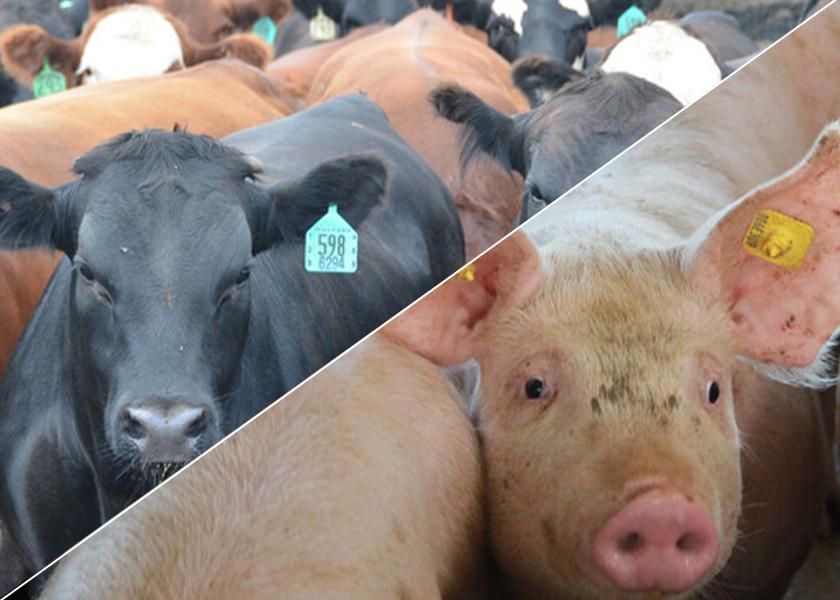Livestock Analysis | June 23, 2022

Price action: Hog futures joined the general commodity rout, with nearby July futures diving $3.30 to $108.55 and August futures plunging $4.65 to $103.675.
Fundamental analysis: Hog futures joined a broad commodity sell-off amid expanding recession fears. The market may be vulnerable to further near-term price downside, but any recession-driven reductions in meat demand may be limited with consumers likely more inclined to eat at home. In that light, today’s hog futures losses look overdone, especially with the declines carrying the nearby contracts to significant discounts to the cash equivalent price.
The next CME Lean Hog Index is expected to drop 7 cents, to $110.67, but is still near a 10-month high. And despite suspicions grocers will soon complete pork purchases for Independence Day features, pork cutout values have stabilized around $111.00. Hog slaughter rates over the next three weeks likely will drop to around the lowest levels of the year. Yet, today’s closes left the July and August contracts at discounts of $2.12 and $7.00 below the preliminary hog index quote. A comparatively large August discount is likely justified due to the seasonal increase in hog supplies experienced after mid-July, but the pessimism now built into futures seems excessive.
Technical analysis: Today’s breakdown flipped the short-term technical advantage in August futures to the bears, especially since the dive carried the contract price down through former support at the contract’s 20-, 40- and 10-day moving averages at $106.79, $106.74 and $105.47, respectively. Those now mark significant resistance levels. Still, renewed strength would have bulls targeting Tuesday’s high at $110.224, then the $115.00 level. Conversely, today’s weak close likely has the bears looking to test the June 13 low at $101.30, the psychological $100.00 level, then the May 12 low at $98.65.
What to do: Be prepared to extend feed coverage on a pullback to the recent lows.
Hedgers: Carry all risk in the cash market for now.
Feed needs: You are hand-to-mouth on corn-for-feed and soybean meal needs.
Price action: June live cattle fell 87.5 cents to $135.25, while most-active August lost $1.05 to $133.875, the lowest closing price since June 13. Feeders bucked the downtrend, with nearby August climbing $1.70 to $174.85.
Fundamental analysis: Live cattle futures fell as recession concerns fueled broad commodity market losses and raised the prospect of consumers cutting back on pricier foods, such as beef. There is some justification for such ideas, since a broad drop in demand for goods and services could undercut price strength up and down the marketing chain. We suspect such fears are overblown in the livestock markets, since the red meat sector has historically held up comparatively well during recessions. Ultimately, current live cattle/meat conditions probably played the main roles in depressing fed cattle prices today. By contrast, feeder futures gained as sharp losses in corn and soymeal lowered anticipated feed costs.
Cash cattle prices slipped Wednesday, with the Monday-Wednesday mean coming in at $138.94, down slightly from the day prior (at $139.11) and down sharply from the comparable week-ago figure. Still, improving trade at higher levels in the Northern Plains should pull that figure up before the weekend. The main driver of today’s cattle weakness may have been the wholesale beef market, which, following an approximate $1.00 drop Wednesday, fell another $1.79 this morning, reinforcing ideas grocers will complete the bulk of their beef purchases for Independence Day features by midweek. Anticipation of sustained seasonal weakness, amplified by recession fears, seemingly bodes ill for the short-term cattle/beef outlook.
Technical analysis: Today’s drop flipped the short-term technical advantage to bears, since it carried the August contract price below former support at its 20- and 40-day moving averages, both at $134.46. That now marks stiff initial resistance, with backing from the contract’s 10-day moving average and today’s high at $135.59 and $135.80, respectively. A reversal back above those levels would have bulls targeting the June 9 high at $137.95, then $140.00. Look for initial support at today’s low of $133.275, then last week’s low at $132.45. A sustained breakdown would then have bears looking to test the pivotal $130.00 level.
Bulls still seem to hold the short-term technical advantage in August feeders. The contract bounced from solid support at its 10-day moving average near $173.37, but also failed to overcome initial resistance at Tuesday’s high of $176.10. A bullish follow-through would face added resistance at the June 9 high of $176.875, but a move above that level would open the door to a test of $180.00. Support at the 10-day moving average is backed by that near its respective 20- and 40-day moving averages near $171.83 and $170.84. A drop below those levels would have bears targeting $170.00, then $165.00.
What to do: Be prepared to extend feed coverage on a pullback to the recent lows.
Hedgers: Carry all risk in the cash market for now.
Feed needs: You are hand-to-mouth on corn-for-feed and soybean meal needs.






